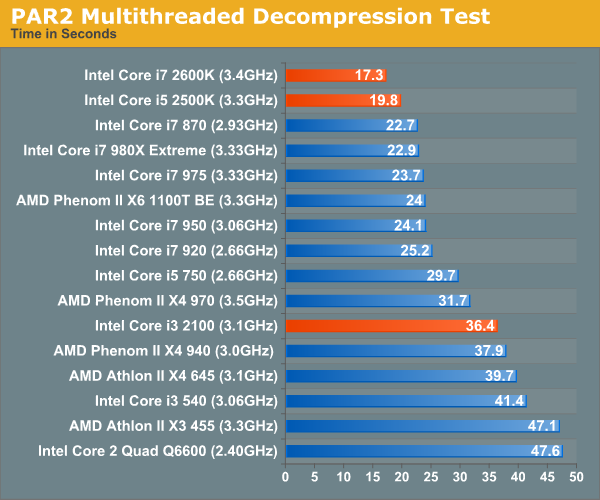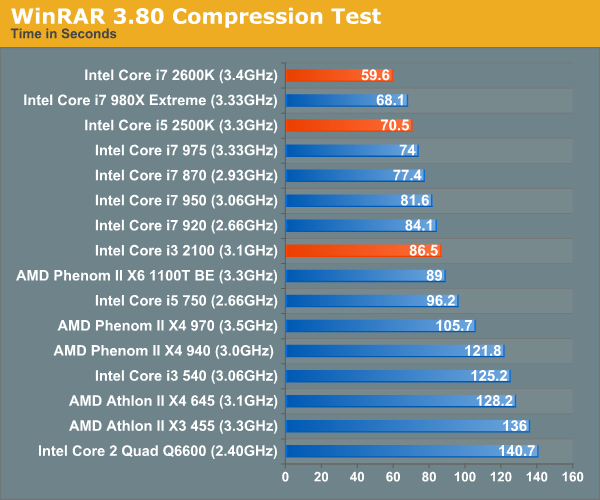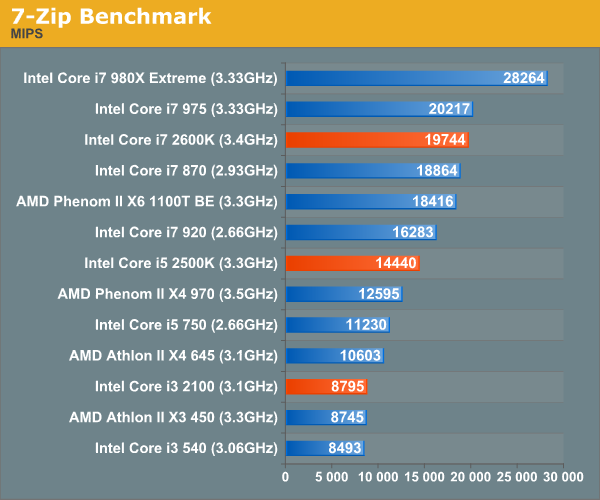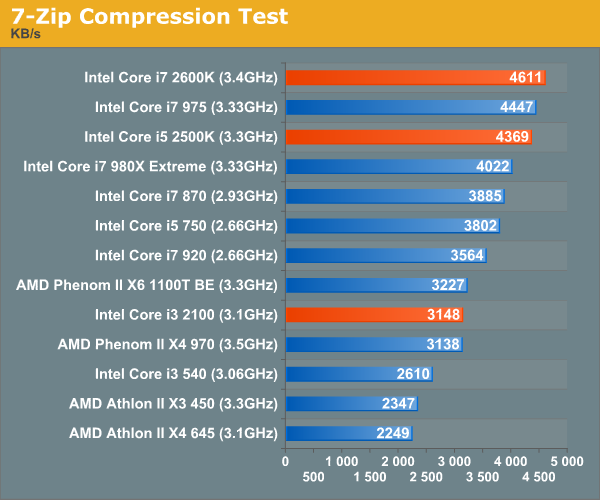The Sandy Bridge Review: Intel Core i7-2600K, i5-2500K and Core i3-2100 Tested
by Anand Lal Shimpi on January 3, 2011 12:01 AM ESTFile Compression/Decompression Performance
Par2 is an application used for reconstructing downloaded archives. It can generate parity data from a given archive and later use it to recover the archive
Chuchusoft took the source code of par2cmdline 0.4 and parallelized it using Intel’s Threading Building Blocks 2.1. The result is a version of par2cmdline that can spawn multiple threads to repair par2 archives. For this test we took a 708MB archive, corrupted nearly 60MB of it, and used the multithreaded par2cmdline to recover it. The scores reported are the repair and recover time in seconds.

Here both the K-series SKUs are faster than the 980X. The Core i3 2100 manages a 13% lead over the Core i3 540.
In all of our compression tests, Sandy Bridge does very well. The 2600K is faster than the 980X in the real world compression tests, while the 7-Zip algorithm benchmark is fully threaded and shows you what would be possible with 6-cores.













283 Comments
View All Comments
IanWorthington - Monday, January 3, 2011 - link
Not really: the board manufacturers seem to be adding usb3 chipsets w/o real problems. Good enough.usernamehere - Monday, January 3, 2011 - link
Sure, if you're building a desktop you can find plenty with USB 3.0 support (via NEC). But if you're looking for a laptop, most will still not have it. For the fact that manufacturers don't want to have to pay extra for features, when they usually get features via the chipsets already included. Asus is coming out with a handful of notebooks in 2011 with USB 3.0 (that I know of), but wide-spread adoption will not be here this year.JarredWalton - Monday, January 3, 2011 - link
Most decent laptops will have USB3. ASUS, Dell, HP, Clevo, and Compal have all used the NEC chip (and probably others as well). Low-end laptops won't get USB3, but then low-end laptops don't get a lot of things.TekDemon - Monday, January 3, 2011 - link
Even the netbooks usually have USB 3.0 these days and those almost all use intel atom CPUs. The cost to add the controller is negligible for large manufacturers. USB is not going to be the deciding factor for purchases.DanNeely - Monday, January 3, 2011 - link
Are you sure about that? Newegg lists 99 netbooks on their site. Searching for USB 3 within netbooks returns 0 products.TekDemon - Monday, January 3, 2011 - link
Your claims are pretty silly seeing as how USB came about in the same way that Light Peak did-Intel invented USB and pushed it to legacy ports like PS/2, and slowly phased out support for the older ones entirely over the years. It makes no sense for them to support USB 3.0, especially without a real market of devices.But motherboard manufacturers will support USB 3.0 via add-in chips. I don't see how this anti-competitive at all, why should intel have to support a format it doesn't think makes sense? So far USB 3.0 hasn't really shown speeds close to it's theoretical, and the only devices that really need the higher bandwidth are external drives that are better off being run off E-SATA anyways. There's no real "killer app" for USB 3.0 yet.
BTW Light Peak will easily support adding power to devices, so it definitely does not need USB in order to provide power. There'll just be two wires running alongside the fiber optics.
DanNeely - Tuesday, January 4, 2011 - link
The eSata + USB (power) connector has never gone anywhere, which means that eSata devices need at least 2 cables to work. Flash drives and 2.5" HDs don't need enough power to require an external brick, and 80-90% of eSata speed is still much better than the USB2 bottleneck. With double the amount of power over USB2, USB3 could theoretically be used to run 3.5" drives with a double socket plug freeing them from the wall as well.ilkhan - Monday, January 3, 2011 - link
I've had my P67A-UD4 for almost 3 weeks now. Lets get the chips out already!I'm confused, however. The fist paragraph talks of 4.1Ghz turbo mode and the chart on page 2 lists 3.8Ghz as the max for the 2600K. Is the chart talking about 4-core turbo or what?
Spike - Monday, January 3, 2011 - link
Isn't it an i7-2600k? The article title says "i5 2600k"... just curious...Ryan Smith - Monday, January 3, 2011 - link
Oh dear...Fixed. Thanks for that.